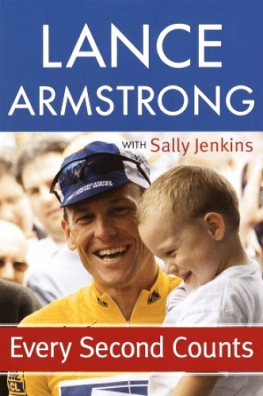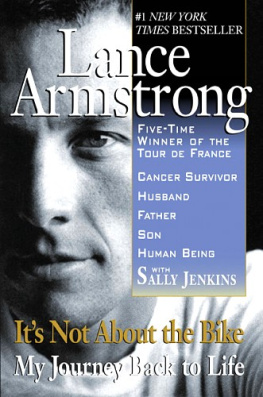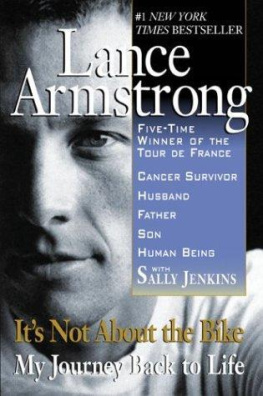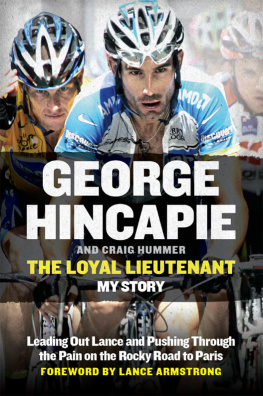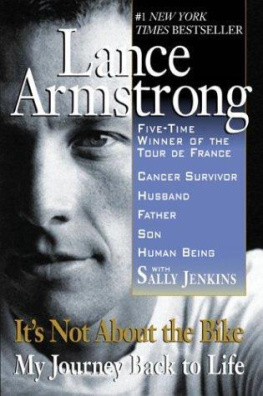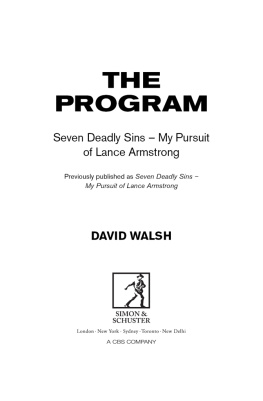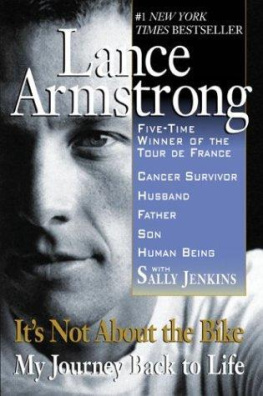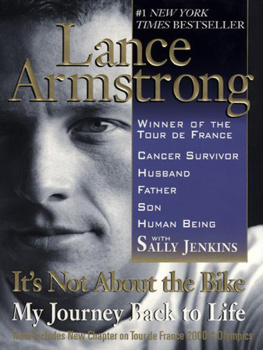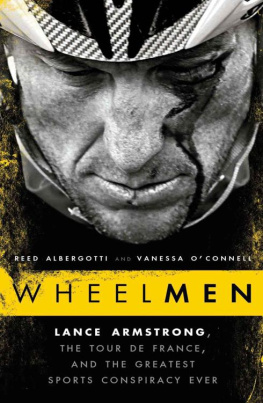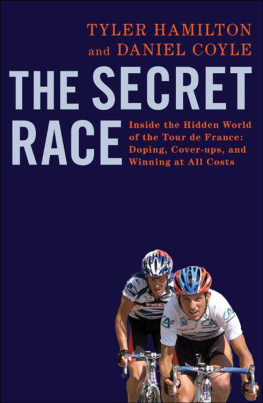
Every
Second
Counts

Lance Armstrong
with Sally Jenkins
Broadway Books
New York
Contents
To Luke, Grace, and Isabelle
for always reminding me that every second really does count
Acknowledgments
The authors would like to offer their deeply felt thanks to the following people, without whom this book could not have been started, and certainly would never have been completed.
Bill Stapleton, Bart Knaggs, and Lee Walker offered unvarnished advice and their ever-sure friendship. Jim Ochowicz, Dr. Craig Nichols, Johan Bruyneel, George Hincapie, Jeff Garvey, and Doug Ullman gave the same, as well as their conscientious service to various causes. Sally Reed and everyone at the foundation are a constant example. Countless other friends, including Scott MacEachren, Dave Mingey, and
Ryan Street
, offered their memories and perspectives. Stacy Creamer of Broadway Books was her usual generous and tremendously patient editor-self, and Stuart Calderwoods care of the manuscript was invaluable.
But they will all understand when I say that my greatest thanks go to my family and to my team, Big Blue.
CHAPTER 1
Pitched Back
S o, it looks as though Im going to liveat least for another 50 years or more. But whenever I need to reassure myself of this, as I sometimes do, I go out to a place called Dead Mans Hole, and I stare down into it, and then, with firm intent, I strip off my shirt and I leap straight out into what you might call the great sublime.
Lets say its my own personal way of checking for vital signs. Dead Mans Hole is a large green mineral pool gouged out of a circular limestone cliff, so deep into the hill country of Texas that its hardly got an address. According to conflicting legends, its either where Confederates tossed Union sympathizers to drown, or where Apaches lured unsuspecting cowboys who didnt see the fall coming. In any event, Im drawn to it, so much so that I bought 200 acres of brush and pasture surrounding it, and Ive worn a road into the dirt by driving out there. It seems only right that a place called Dead Mans Hole should belong to a guy who nearly diedand who, by the way, has no intention of just barely living.
I stand there next to a 45-foot waterfall and examine the dropand myself, while Im at it. Its a long drop, so long that it makes the roof of my mouth go dry just looking at it. Its long enough for a guy to actually think on the way down, and to think more than one thought, too. Long enough to think first one thing, A little fear is good for you , and then another, Its good for you if you can swim , and then one more thing as I hit the water: Oh fuck, its cold . As I jump, there are certain unmistakable signs that Im alive: the press of my pulse, the insistent sound of my own breathing, and the whanging in my chest thats my heart, which by then sounds like an insubordinate prisoner beating on the bars of my ribcage.
I come up whooping through the foam and swim for the rocks. Then I climb back up and towel off, and I drive home to my three kids. I burst through the door, and I shout at my son, Luke, and my twin daughters, Grace and Isabelle, and I kiss them on the necks, and I grab a Shiner Bock beer with one hand and an armful of babies with the other.
The first time I ever did it, my wife, Kik, just looked at me and rolled her eyes. She knew where Id been.
Was that clarifying for you? she said.
A t what point do you let go of not dying? Maybe I havent entirely and maybe I dont want to.
I know theyre out there, lying in their hospital beds, with those damn drip poles, watching the damn chemo slide into their veins, and thinking, This guy had the same thing I do. If he can do it, I can, too . I think of them all the time.
My friend Lee Walker says I got pitched back. What he means is, I almost died, and possibly even did die a little, but then I got pitched back into the world of the living. Its as good a description as any of what happened. I was 25 when cancer nearly killed me: advanced choriocarcinoma spread to my abdomen, lungs, and brain and required two surgeries and four cycles of chemotherapy to get rid of. I wrote an entire book about death, called Its Not About the Bike , about confronting the possibility of it, and narrowly escaping it.
Are you sure? I asked the doctor.
Im sure.
How sure?
Im very sure.
How can you be so sure?
Im so sure that Ive scheduled you for surgery at 7 A . M . tomorrow.
Mounted on a light table, the X-ray showed my chest . Black meant clear; white meant cancer. My chest looked like a snowstorm.
What I didnt and couldnt address at the time was the prospect of life. Once you figure out youre going to live, you have to decide how to, and thats not an uncomplicated matter. You ask yourself: now that I know Im not going to die, what will I do? Whats the highest and best use of my self? These things arent linear, theyre a mysterious calculus. For me, the best use of myself has been to race in the Tour de France, the most grueling sporting event in the world.
Every time I win another Tour, I prove that Im aliveand therefore that others can survive, too. Ive survived cancer again, and again, and again, and again. Ive won four Tour titles, and I wouldnt mind a record-tying five. That would be some good living.
But the fact is that I wouldnt have won even a single Tour de France without the lesson of illness. What it teaches is this: pain is temporary. Quitting lasts forever.
To me, just finishing the Tour de France is a demonstration of survival. The arduousness of the race, the sheer unreasonableness of the job, the circumnavigation of an entire country on a bicycle, village to village, along its shores, across its bridges, up and over the mountain peaks they call cols, requires a matchless stamina. The Tour is so taxing that Dutch rider Hennie Kuiper once said, after a long climb up an alp, The snow had turned black in my eyes. Its not unlike the stamina of people who are ill every day. The Tour is a daily festival of human suffering, of minor tragedies and comedies, all conducted in the elements, sometimes terrible weather and sometimes fine, over flats, and into headwinds, with plenty of crashes. And its three weeks long. Think about what you were doing three weeks ago. It feels like last year.
The race is very much like livingexcept that its consequences are less dire and theres a prize at the end. Life is not so neat.
There was no pat storybook ending for me. I survived cancer and made a successful comeback as a cyclist by winning the 1999 Tour, but that was more of a beginning than an end. Life actually went on, sometimes in the most messy, inconvenient, and un-triumphant ways. In the next five years Id have three children, take hundreds of drug tests (literally), break my neck (literally), win some more races, lose some, too, and experience a breakdown in my marriage. Among other adventures.
When you walk into the Armstrong household, what you see is infants crawling everywhere. Luke was born in the fall of 1999 to Kristin (Kik) Armstrong and me shortly after that first Tour, and the twins came in the fall of 2001. Grace and Isabelle have blue saucer eyes, and they toddle across the floor at scarcely believable speeds. They like to pull themselves upright on the available furniture and stand there, wobbling, while they plan how to make trouble. One of Isabelles amusements is to stand up on the water dispenser and press the tap until the kitchen floods, while she laughs hysterically. I tell her, No, no, no, and she just shakes her head back and forth and keeps laughing, while the water runs all over the floor. I cant wait for their teen years.

